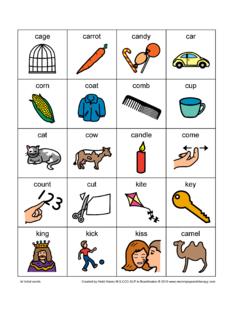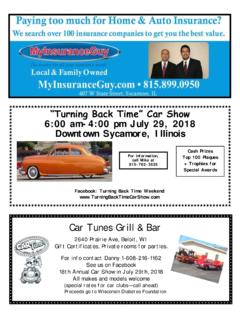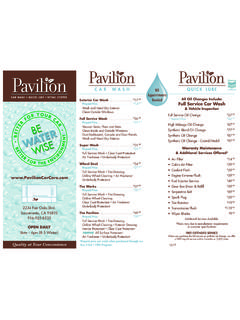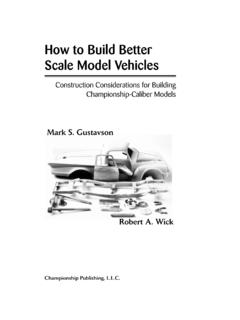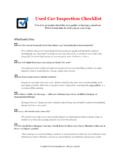Transcription of An Actual Driving Lesson Learning to drive an …
1 An Actual Driving Lesson Learning to drive an automatic car Where are the controls that I might have to use in my Driving : Knowing where the controls are, and being able to locate and use them without looking away from the road is important. Remember in each vehicle these controls could be in different places: - Washer and wiper, front and back - Head lights, high and low beam - Hand brake - Demisters, front and back - Horn - Hazard lights - Indicators How to adjust the seat: When adjusting the seat, your right leg should be able to reach the accelerator and brake pedals comfortable and have a slight bend in it (about 15 degrees).
2 The leg should not be fully extended. Push your shoulder into the back of the seat, and put your arms out in front of you at the top of the steering wheel, now adjust the back of the seat so your wrists are on top of the steering wheel rim (not your hand or arm but your wrist). Most cars now can adjust the height of the steering wheel. Move the steering wheel up or down so you can see the speedo clearly. How to adjust your mirrors: The mirrors should be adjusted so when you look into them, you are only moving your eyes not your head. The centre mirror: The top of your mirror should run along the top of your back window, you should be able to see the whole back window.
3 The side mirrors: On a flat road, you should see road from the middle of the mirror to the bottom of the mirror, and from the middle of the mirror to the top of the mirror you should see houses, trees, sky etc. The bottom corner near the door of the mirror you should be able to see the back door handle Stage 1 BUILDING A SOLID FOUNDATION In this part of Learning you do it until you get it right. You will do lots of Driving and hopefully turn action into habits, fix your mistakes. Repetition after repetition, do the same thing hundreds times of the correct repetition. (Sounds like fun doesn t it). Learning the basic Driving skills During this stage the focus is on stopping and starting, acceleration and slowing down and steering (this is the frustrating stage of Driving ).
4 Get the licensed driver to drive the car to a clear open road. We need a quiet road with few vehicles - a long straight road is perfect, no intersections. The safe way to get started Once a quiet road is found pull over to the side of the road, make the car safe (hand brake on, switch off the car). Change seats so the learner is in the driver s seat and adjust the seat, mirror and steering wheel as demonstrated in that chapter. What are these pedals on the floor for? Look down at your feet - you will see two pedals. The pedal on the left is the brake (which stops or slows down the car). That pedal is used by the right leg only.
5 The pedal on the right is the accelerator (which makes the car gather speed, or give it more power) that is also used by the right leg. Your left leg is for balance only, not to operate any of the pedals. It should be on the floor or on the foot rest if your car has one. How do I work the gear shift Different automatic cars have different type of gear panels , but most common is this panel. P - PARK. This locks the transmission.
6 Use this when stationary. Some cars require stepping on the brake pedal before you can push into another gear. R - REVERSE. To make the car go backward. N - Neutral. No gear. This can be selected when stationary at an intersection / traffic lights but make sure you have your foot on the brake because in this position the car can roll forwards or backwards if you are on a slope. D - drive . To make the car go forward. 1 - First Gear.
7 The car is locked in 1st gear. Used for when you need high rev Driving . In sand, mud, going up or down steep hills. Bad weather conditions. 2 - Second Gear . The car will move between 1st and 2nd gear. Used for when you need more power. Use when over taking a car. Bad weather conditions like snow. Starting the car. Make sure you follow this procedure or else the car will more likely take off without warning. We don t want any mishaps yet because at this stage we are doing well . - Make sure the gear shift is in P - Make sure the hand brake is fully on.
8 - Foot on the brake pedal. - Turn the ignition key clockwise. - As soon as the engine revs up let the key go. (The key will spring back in to position.) Congratulations! you have now started the car. Make sure the gear shift is still in P and hand brake is on; relax for a minute or two. The car should be idling along (there is no hurry). Let s get the car moving At this stage we only going to get the car to roll forward a few metres. We are not Driving off yet. - Right foot depressed on the brake pedal. (This will stop the car moving forward unexpectedly) - Move the gear shift into D position. (The car is now in gear) - Release the hand brake.
9 - Slow release your foot from the brake pedal. (As you release the foot brake the car will start moving forward). - After few metres smoothly bring the car to a stop with your brake pedal. - Put gear shift in P position. - Hand brake on. - Repeat, repeat, repeat until you feel confident. Common errors may occur. - If you cannot move the gear shift to D position press down on the brake pedal a bit harder. - Have not properly selected the D position (The N position is the common error) - If you are on an up slope, it may need a slight accelerator to get the car moving. We are really doing it for real for the first time ( Watch out everybody I m coming ) We are going to drive on the road now.
10 We will only take the car up to about 60km/h and hold it there to get the feel of the car moving. Let s do it. - Right foot on the brake pedal. - Move the gear shift to D - Hand brake off. - Check to see if it is safe to merge onto the road. (If it s not safe, wait until it is). - Slowly release your foot off the brake pedal. - Very slowly accelerate and steer onto the road Keep it slow until you are on the road - Gently accelerate until you reach about 60km/h. - When you reach that speed keep the speed steady. Just practice holding the car steady for a few minutes. Its takes practise to do this. It looks easy when another driver does it, but this takes practise too do it.

